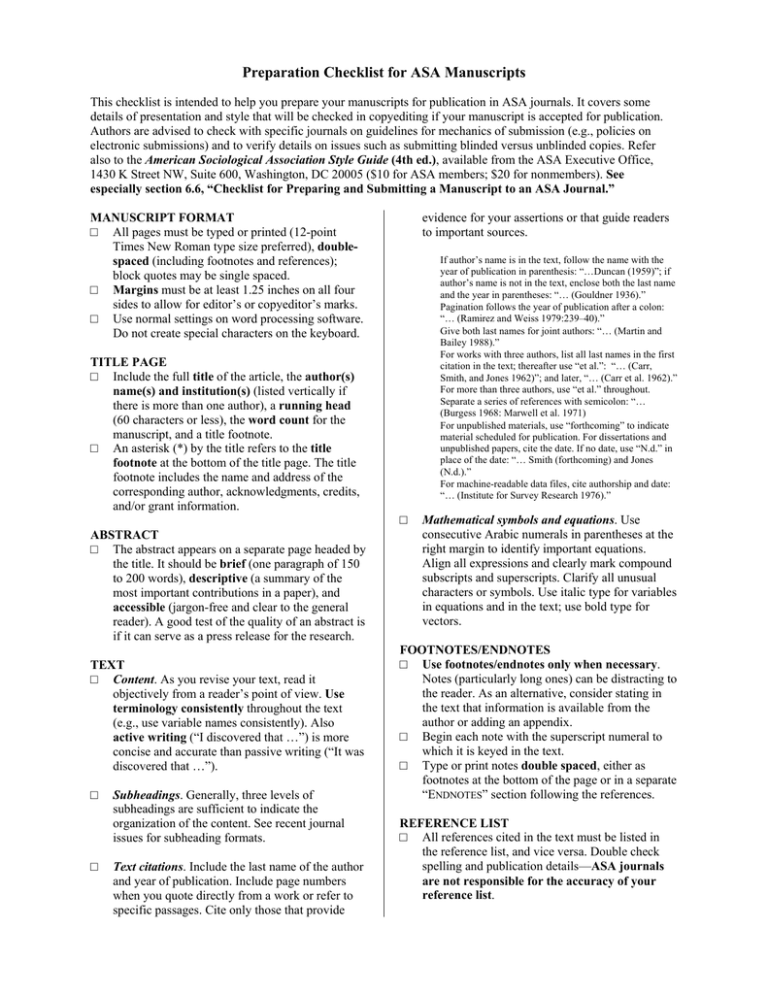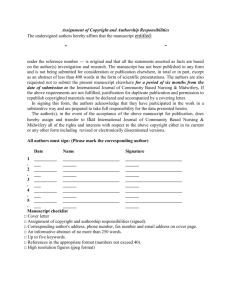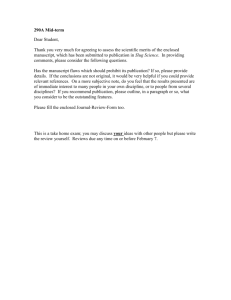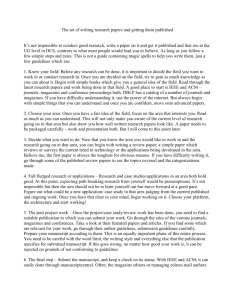Preparation Checklist for ASA Manuscripts
advertisement

Preparation Checklist for ASA Manuscripts This checklist is intended to help you prepare your manuscripts for publication in ASA journals. It covers some details of presentation and style that will be checked in copyediting if your manuscript is accepted for publication. Authors are advised to check with specific journals on guidelines for mechanics of submission (e.g., policies on electronic submissions) and to verify details on issues such as submitting blinded versus unblinded copies. Refer also to the American Sociological Association Style Guide (4th ed.), available from the ASA Executive Office, 1430 K Street NW, Suite 600, Washington, DC 20005 ($10 for ASA members; $20 for nonmembers). See especially section 6.6, “Checklist for Preparing and Submitting a Manuscript to an ASA Journal.” evidence for your assertions or that guide readers to important sources. MANUSCRIPT FORMAT □ All pages must be typed or printed (12-point Times New Roman type size preferred), doublespaced (including footnotes and references); block quotes may be single spaced. □ Margins must be at least 1.25 inches on all four sides to allow for editor’s or copyeditor’s marks. □ Use normal settings on word processing software. Do not create special characters on the keyboard. If author’s name is in the text, follow the name with the year of publication in parenthesis: “…Duncan (1959)”; if author’s name is not in the text, enclose both the last name and the year in parentheses: “… (Gouldner 1936).” Pagination follows the year of publication after a colon: “… (Ramirez and Weiss 1979:239–40).” Give both last names for joint authors: “… (Martin and Bailey 1988).” For works with three authors, list all last names in the first citation in the text; thereafter use “et al.”: “… (Carr, Smith, and Jones 1962)”; and later, “… (Carr et al. 1962).” For more than three authors, use “et al.” throughout. Separate a series of references with semicolon: “… (Burgess 1968: Marwell et al. 1971) For unpublished materials, use “forthcoming” to indicate material scheduled for publication. For dissertations and unpublished papers, cite the date. If no date, use “N.d.” in place of the date: “… Smith (forthcoming) and Jones (N.d.).” For machine-readable data files, cite authorship and date: “… (Institute for Survey Research 1976).” TITLE PAGE □ Include the full title of the article, the author(s) name(s) and institution(s) (listed vertically if there is more than one author), a running head (60 characters or less), the word count for the manuscript, and a title footnote. □ An asterisk (*) by the title refers to the title footnote at the bottom of the title page. The title footnote includes the name and address of the corresponding author, acknowledgments, credits, and/or grant information. □ ABSTRACT □ The abstract appears on a separate page headed by the title. It should be brief (one paragraph of 150 to 200 words), descriptive (a summary of the most important contributions in a paper), and accessible (jargon-free and clear to the general reader). A good test of the quality of an abstract is if it can serve as a press release for the research. TEXT □ Content. As you revise your text, read it objectively from a reader’s point of view. Use terminology consistently throughout the text (e.g., use variable names consistently). Also active writing (“I discovered that …”) is more concise and accurate than passive writing (“It was discovered that …”). □ □ Subheadings. Generally, three levels of subheadings are sufficient to indicate the organization of the content. See recent journal issues for subheading formats. Text citations. Include the last name of the author and year of publication. Include page numbers when you quote directly from a work or refer to specific passages. Cite only those that provide Mathematical symbols and equations. Use consecutive Arabic numerals in parentheses at the right margin to identify important equations. Align all expressions and clearly mark compound subscripts and superscripts. Clarify all unusual characters or symbols. Use italic type for variables in equations and in the text; use bold type for vectors. FOOTNOTES/ENDNOTES □ Use footnotes/endnotes only when necessary. Notes (particularly long ones) can be distracting to the reader. As an alternative, consider stating in the text that information is available from the author or adding an appendix. □ Begin each note with the superscript numeral to which it is keyed in the text. □ Type or print notes double spaced, either as footnotes at the bottom of the page or in a separate “ENDNOTES” section following the references. REFERENCE LIST □ All references cited in the text must be listed in the reference list, and vice versa. Double check spelling and publication details—ASA journals are not responsible for the accuracy of your reference list. □ □ □ □ List references in alphabetical order by authors’ last names. Include full names of all authors—use first name initials only if the author used initials in the original publication. For multiple authors, invert only the name of the first author (e.g. “Jones, Arthur B., Colin D. Smith, and Barrie Thorne”). For two or more references by the same author(s) or editor(s), list them in order of the year of publication. Give the author’s (or editor’s) full name in all subsequent references. Arrange references for the same single author from the earliest to the latest. All single author references precede references with multiple authors, even though they may have been published earlier. References with multiple authors are arranged in alphabetical order of author’s last names. To list two or more works by the same author(s) from the same year, distinguish them by adding letters (a, b, c, etc.) to the year or “Forthcoming” (e.g., 1992a, Forthcoming a). List in alphabetical order by title. A few examples follow. See recent journal issues for further examples: Books Mason, Karen O. 1974. Women’s Labor Force Participation and Fertility. Research Triangle Park, NC: National Institutes of Health. Periodicals Aseltine, Robert H., Jr. and Ronald C. Kessler. 1993. “Marital Disruption and Depression in a Community Sample.” Journal of Health and Social Behavior 34(3):237–51. Collections Clausen, John A. 1972. “The Life Course of Individuals.” Pp. 457–514 in Aging and Society. Vol. 3, A Sociology of Age Stratification, edited by M. W. Riley, M. Johnson, and A. Foner. New York: Russell Sage. Web Site (No Author) American Anthropological Association. 2006. “Race.” Retrieved July 10, 2010 (http://www.aaanet.org/_cs_upload/resources/ 14737_1.pdf/). BIOGRAPHY Include a short biography (five or six lines) for each author, which should include the author’s name, title, department, institution, and a brief description of current research interests, publications, or awards. TABLES, FIGURES, AND APPENDICES Include tables, figures, and appendices only when they are critical to the reader’s understanding. Tables □ Number tables consecutively throughout the text. Type or print each table on a separate page at the end of the manuscript. □ Include a descriptive title and headings for all columns and rows (see recent journal issues for examples). □ Always use the same variable names in tables as in the text. □ Include standard errors, standard deviations, t statistics, and so forth in parentheses under the means or coefficients in the tables. □ Gather general notes to tables as “Note:” or “Notes:” at the bottom of the table; use a, b, c, etc., for table footnotes. □ Use asterisks *, **, and/or *** (asterisks) to indicate significance at the p < .05, p < .01, and p < .001 levels, respectively; note if tests are onetailed or two-tailed. Generally, only those results significant at the p < .0 level or better should be indicated as significant in the tables or text. Figures and Other Artwork □ Number figures or illustrations consecutively throughout the text. Each should include a title. If the manuscript is accepted for publication, submit figures and illustrations electronically. All labels on figures and illustrations must be typeset. □ IMPORTANT: Before submitting a figure or illustration for publication, contact the journal editorial office to discuss size specifications and/or disk and file formats. All artwork and type must be legible when sized to fit one or two column widths, 2-9/16 and 5-5/16 inches wide, respectively (standard column widths for ASA journals). Author(s) must secure permission to publish any copyrighted figure, illustration, or photograph. Appendices □ Appendices appear at the end of the article and should be labeled “Appendix A,” “Appendix B,” etc. REVIEW YOUR MANUSCRIPT □ Although authors should note that these functions may not always be reliable, run spell and grammar checks on your manuscript from your word processing software. □ Carefully read through the entire manuscript one final time before submitting.



